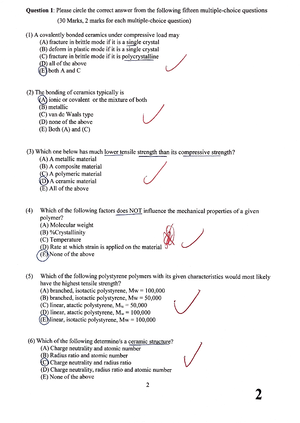- Information
- AI Chat
Was this document helpful?
Lab Report - tensile test
Course: Materials 1 (AMME1362)
92 Documents
Students shared 92 documents in this course
University: University of Sydney
Was this document helpful?

Kevin Fernandes 450482274
Laboratory Report
Aim:
Conducting the tensile tests on the three different types of materials was conducted in order to
measure the elongation of the specific material with respect to how much load was applied, and to
further investigate the mechanical properties of each of the materials.
Background:
Although the entire sample material was exposed to the loads applied by the machine, the stress was
focused on the gauge length of the material. Carrying out the tensile test required a variation in load
on the gauge length of the material, and adversely affected the engineering strain and stress the
gauge length of the material was exposed too. The load (F) refers to the quantity of force applied
upon the sample material and that can be measured. The gauge length (l) refers to the rectangular
portion of the specimen being tested where elongation is measured. Engineering stress (!) is the
instantaneous load applied to a specimen divided by its cross sectional area, and engineering strain
(ϵ) is given by the gauge length of the tested specimens divided by the original gauge length, and it
measures the elongation within the gauge length of the sample.
Method:
1. Obtain the appropriate measurements required from the sample undergoing the tensile test to
calculate the cross sectional area.
2. Put the sample material in the jaws of the tensile testing machine. Attempt to make sure that
there is no angular difference between the placement of the sample material within both jaws
of the apparatus. This could have an adverse affect on the accuracy of the results.
3. Place the extensometer clips on the gauge length of the material. Note that the extensometer
wonÕt work when testing the nylon samples due to the amount of elongation that nylon
experiences.
4. Input the appropriate pulling rate for that material within the apparatusÕs computer (e.g. nylon
would require a higher pulling rate than the other materials to speed up the process).
5. Start the tensile testing machine and gather appropriate data from the computer.
Sketch/ Drawings of specimen:
1







